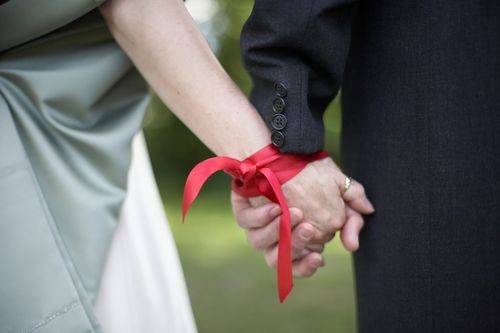 There are many different elements that can make a couple's wedding special. If the couple you are marrying has asked you to use a handfasting ceremony script as they express their vows, it's important that you understand the basics of the ritual.
There are many different elements that can make a couple's wedding special. If the couple you are marrying has asked you to use a handfasting ceremony script as they express their vows, it's important that you understand the basics of the ritual.
What Is It?
Handfasting is rooted in Celtic tradition. It is mostly used in Pagan or Wiccan ceremonies today, but some other religious or secular circles find meaning in the ritual. Essentially, the couple's hands are bound together as part of their vow exchange. Many experts believe this is where the phrase "tying the knot" originated. A basic handfasting ritual script contains a few key elements:
- Officiant gives an overview.
- Officiant instructs the couple to join hands.
- Cords or bands are wrapped around the enjoined hands as the vows are read.
- Once bound, the officiant gives more detail about what the ritual means to the couple.
- Additional vows may be exchanged.
What Does the Ritual Signify?
The tying of material around the hands of the couple gives a visual representation of their bond. There is no particular material required, but the couple may choose whatever signifies their bond most accurately. For example, some use different colored ribbons, with each color symbolizing a different aspect of their union. Others choose natural garlands as a nod to Mother Earth or braided cords to represent the strength of their relationship.
The officiant is usually the one to tie the cords as part of the handfasting script, but the couple may opt to have specific friends or family members participate in this part of the service. This choice can show that the couple is surrounded by people who revere their relationship and will also commit to supporting their bond as the marriage progresses.
What Is the Timeframe for the Ceremony?
The most common time for handfasting to occur during a wedding is during the exchange of the vows. After the ordained minister explains what the different elements of the ritual symbolize and the couple's hands are bound together, the vows are either read by the officiant or recited by the couple. The ties may remain through the rest of the service.
Other couples prefer to use a simple handfasting ceremony to announce the official start of their engagement. Their hands are bound together as they commit to examining their relationship during the period before their wedding to ensure that they are a lasting match. This can occur in a private ceremony or as a celebration with close friends and family.
What Is Said During the Ritual?
There are many ways you can make a wedding meaningful for participants. Some of those who attend the wedding may have never heard of handfasting before, so a little explanation is in order before you begin. What you say during the wedding begins with your consultation with the couple. You may think you have a grasp on what handfasting means, but it's their personal connection to the ritual that will inspire the specific way you approach it at the ceremony.
Focus on the parts of the ritual that are important to the couple. Some pairs may want you to delve into handfasting's historical roots, while others may want you to explain what the materials they've chosen mean to them. As with all parts of the ceremony, your words should mirror the wishes of the couple.
If this ritual is something the couple you're marrying wants to incorporate into their service, start with a simple handfasting ceremony script and adapt it to their preferences. The ritual can add depth to a wedding by literally binding the couple as they begin their lives together.
Add Your Comment